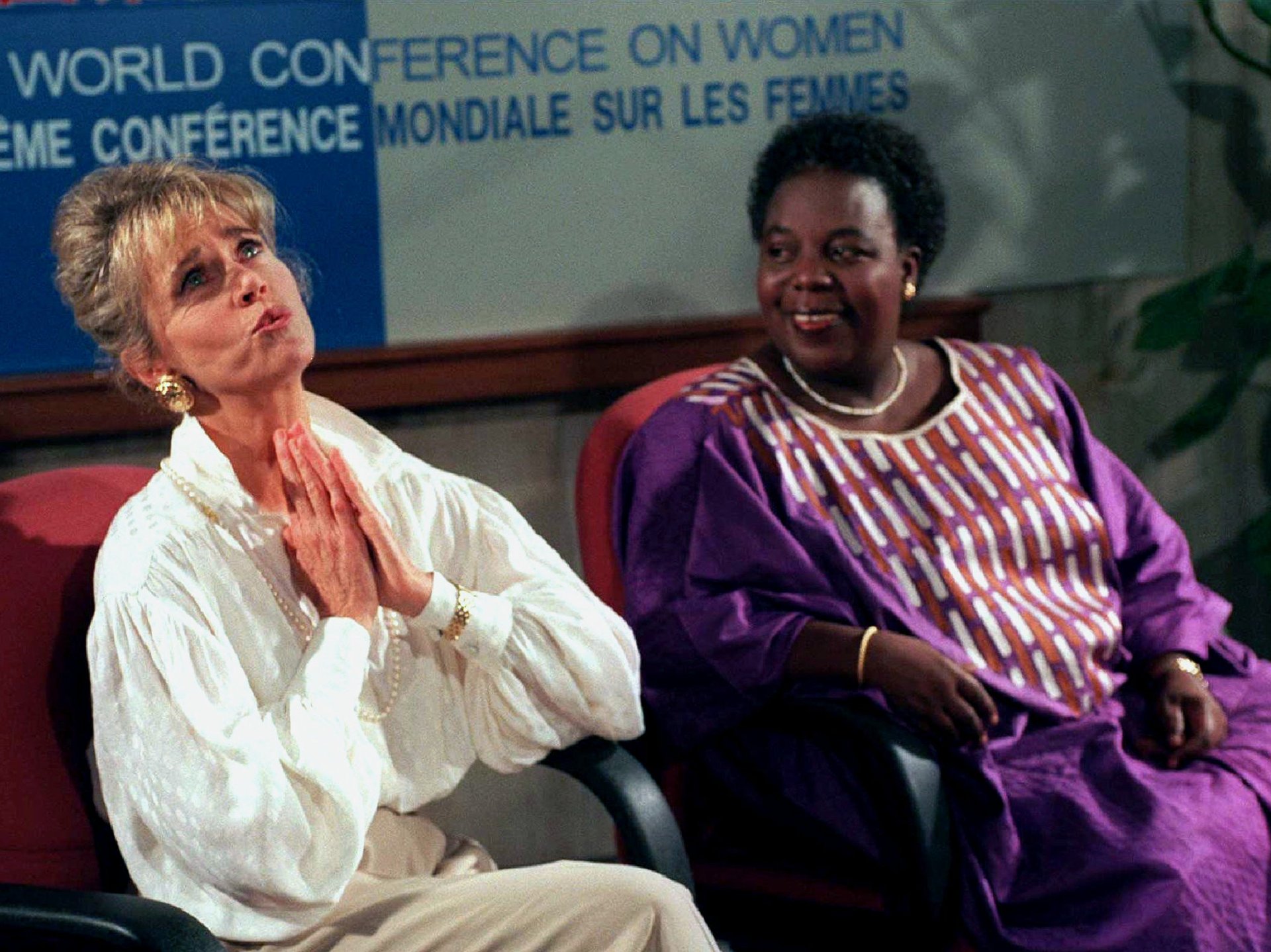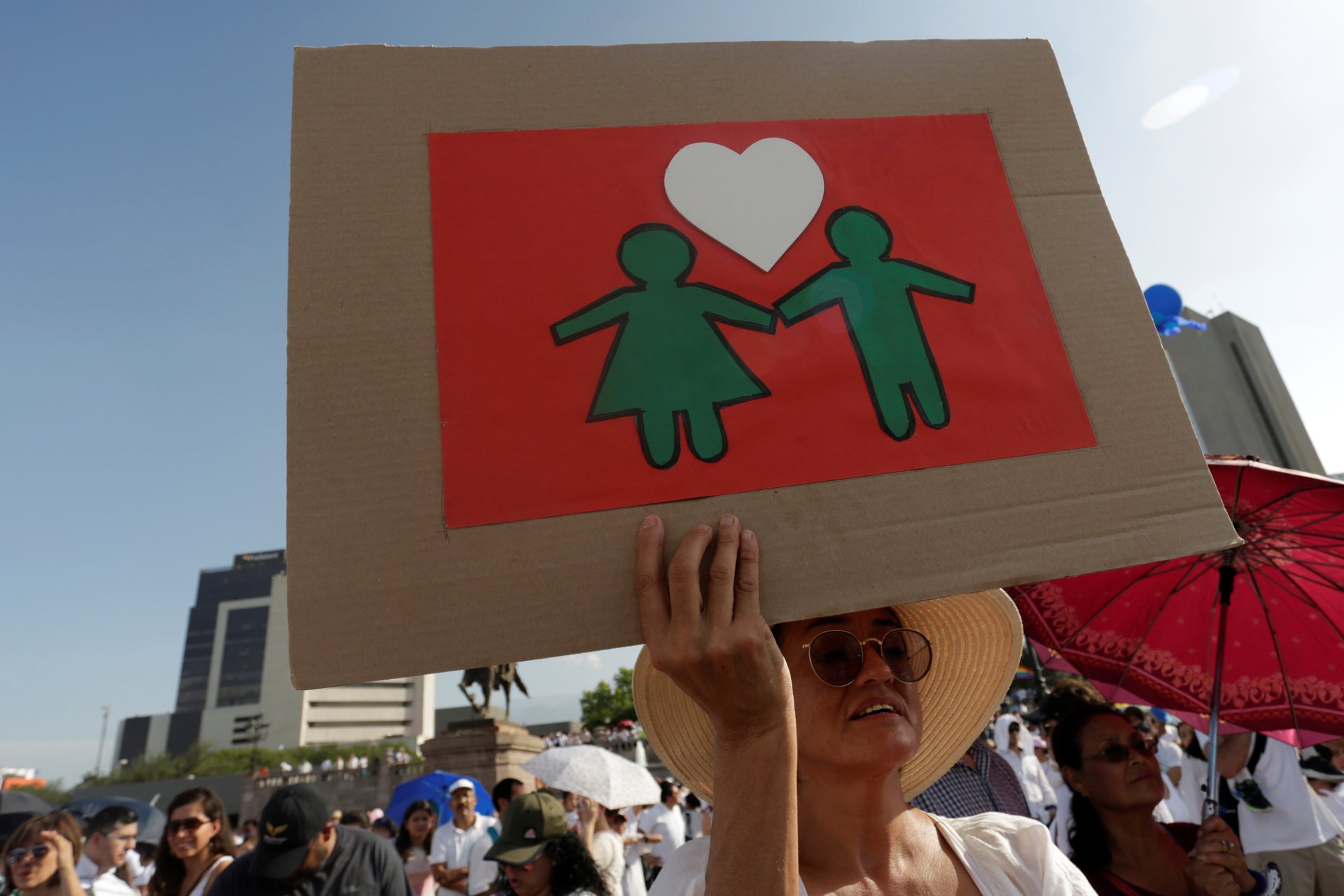A conspiracy theory about sex and gender is being peddled around the world by the far right
A new term has been creeping into the speech of conservatives around the world.


A new term has been creeping into the speech of conservatives around the world.
In Mexico, thousands of protesters denounced the spread (link in Spanish) of “gender ideology” in marches against same-sex marriage this September. Weeks earlier, religious groups in Colombia accused the government of wanting to indoctrinate children by teaching “gender ideology” in schools; weeks later, they would accuse officials of injecting similar forms of treachery (Spanish) into an attempted peace deal to end the country’s half-century of civil war.
Activists in Spain and Poland have used the same phrase to combat efforts to recognize that gender identity and sexual orientation go beyond heterosexual men and women. In France, the idea has circulated (link in French) under the slightly different “gender theory.” Even Pope Francis raised the notion last month, urging priestly compassion for individuals grappling with their gender identity or sexual orientation but rejecting “the indoctrination of gender theory” and its “ideological colonization.”
What is this seemingly ubiquitous ideology that has Catholics and other conservatives so nervous? According to them, it’s a worldview, concocted by lesbian academics and radical feminists, that gender has nothing to do with biological differences and can be chosen at will. They characterize it as a dangerous line of thought that threatens to infect children and destroy democracy.
In fact, “gender ideology” is an invention of the right. It’s a hodgepodge of disparate ideas developed by a diverse group of thinkers over the past 50 years, linked mainly in the minds of its opponents. It doesn’t really exist beyond its creators’ manifestos and protest banners, but it’s already helped them score some very real victories.
Gender-phobia
The Catholic church and other conservative groups have long had a problem with gender understood as the cultural layer of behaviors and traits that societies slather atop biological sex. This perspective challenges many of their notions about how humanity should be organized, modeled in the “family values” ascribed to them. If traditional roles of husband and wife, father and mother, man and woman are merely social constructs, then other identities beyond those binaries become just as valid, injecting chaos into the order of things.
“Gender ideology” is the straw man they invented to fight against this threat. Its origins can be traced back to two United Nations summits that addressed gender inequality and women’s sexual and reproductive rights: the 1994 conference on population and development in Cairo, and the women’s conference in Beijing the following year.

Even before the conferences, the Vatican preemptively denounced what it claimed were efforts to unite the world in favor of abortion and sex for nonreproductive purposes, including same-sex relations. In their aftermath, some Catholics fixated on the term “gender,” calling it a Trojan horse to force anti-family policies unto society, according to David Paternotte, a professor at the Free University of Brussels who has studied the “gender ideology” phenomenon.
As it turned out, the idea of gender also offered a very powerful framework to oppose those policies, including same-sex marriage and adoption, sexual education in schools, the right to abortion, alternative reproduction methods, and transgender rights. All of those could be wrapped into the concept of “gender ideology” and combated using the same argument: men and women are not equal, but complementary by natural design. The construct is “a vessel that can be used for different purposes,” says Paternotte.
Conservative activists laid out their ideas in books and manifestos (Spanish,) and in Lexicon: Ambiguous and debatable terms regarding family life and ethical questions, a dictionary published in 2003 by the Vatican’s Pontifical Council for the Family. Lexicon sought to expose the “Orwellian language” that was being used to spread “gender ideology” around the globe. For example, cardinal Alfonso López Trujillo writes in the book’s preface, the phrase “discrimination against women” might at first “arouse a sympathetic reaction.” In fact, he explains, it’s an attack on the family, which is framed as “a place of modern slavery.”
“The family and life are being literally bombarded by a deceptive language,” López Trujillo argues. “Without the pursuit of the truth, the universe of freedom is contaminated and in serious danger.”
Among the terms included in Lexicon: “patriarchy,” “matriarchy,” “homosexual marriage,” and of course “gender ideology.”
Supposed sources
The opponents/creators of “gender ideology” attribute the concept to a variety of writers, from Simone de Beauvoir, the French intellectual who was part of the existentialist movement in the 1950s, to radical feminists of the 1970 such as the late Shulamith Firestone, to Judith Butler, a philosopher and gender theorist who teaches at the University of California, Berkeley.
All those authors address gender and use some of the words included in the Lexicon. But their work can’t be construed as a single, unified way to conceive of gender as their opponents claim. The notion that it does is “fantasy,” says Camille Robcis, a history professor at Cornell University who has studied the deployment of ”gender ideology” in France.
For starters, Robcis notes, the writings of these alleged architects of “gender ideology” sprouted from different historical contexts—when de Beauvoir famously wrote “one is not born, but rather becomes, a woman,” the LGBTI label did not exist.
The ideas of these thinkers, far from uniform, are often far more complicated than the easy sound bites they’ve been reduced to in the “gender ideology” fight. Take Butler, one of the authors most widely criticized by anti-gender ideology crusaders. Readers describe getting through her work as challenging, or as one Quora user put it, akin to “flying face-first into a wall of solid india-rubber and then having to gnaw your way through.” It is not the stuff of simple slogans (link in French) like the “We want sex, not gender” protest banners used in French demonstrations.

Also lost in the “gender ideology” origin story is the simple fact that the people accused of starting the movement had no common agenda they were trying to push.
Even among today’s alleged promoters of “gender ideology”—the governments and LGBTI activists at odds with conservative policies—there is no united front on gender issues. In fact, says Mary Anne Case, a professor at University of Chicago Law School, they are not even making the same connections their opponents do between issues such as same-sex marriage and abortion.
“I wish we were as united as the Vatican thinks we are, and as powerful,” says Case, who has written about the origins of “gender ideology.”
In reality, Case says, not only is “gender ideology” made up, but so is the conspiracy under which its supposed proponents are working together.
Brilliant strategy
“Gender ideology” has been a very effective communication and persuasion tool. It helps its “fighters” to avoid overtly homophobic language—which is prohibited by law in some countries—and to frame their arguments in secular terms. For example, instead of saying that same-sex marriage goes against religious teachings, opponents argue that it threatens the natural order of things.
In an analogy used by critics including Pope Benedict XVI in his 2008 Christmas greetings, the nature of human beings as men and women is a rain forest under threat. In the same vein, in some of the materials distributed by French protestors, former French justice minister Christiane Taubira, who proposed a same-sex marriage law, was depicted holding a chainsaw amid a chopped-down forest.
By oversimplifying the issues, the concept of “gender ideology” allows conservatives to package them in ways that are easy to understand—and contest. “A boy and a girl, they’re not the same,” explains the video below produced by the French conservative coalition La Manif Pour Tous, or Protest for All. The video asserts that in the name of ending gender inequality, some are trying to mix up feminine and masculine traits in a way that confuses children. “Yes, dad can wear a dress and lipstick. Yes, a girl can drive a bus. Yes, a baby can have two mothers or two fathers.”
“Let girls be girls. Let boys be boys,” it concludes.
Without being familiar with the more nuanced views of gender developed by the intellectuals whom conservatives are criticizing, it’s easy to take the distorted interpretation at face value. That’s made it possible for conservative groups to convince followers that policies designed to instill basic human rights—a clear state jurisdiction—are really an imposition of a fringe ideology that the state has no business institutionalizing. In other words, the very people acting on their religious beliefs have successfully framed gender issues as a religion itself. It’s a master class in the doublespeak they see themselves as trying to combat.
A global ideology
Although the idea of “gender ideology” has been around for several years, its use has picked up recently as more countries started addressing LGBT rights. Conservative mobilizations across Europe, including in Slovakia, Slovenia, Belgium, Lithuania, and Poland, are underpinned by the concept, as Paternotte, the Brussels Free University professor, has observed. The trigger has been different in each country, he says, and so is how the strategy plays out.
In France, for example, the movement propelled hundreds of thousands of protesters into the streets, and has exerted real pressure on the government. It failed to derail a bill to legalize same-sex marriage in 2013, but it ended a push for other measures, such as extending to non-heterosexual people the right to use alternative reproduction technologies, says Bruno Perreau, an MIT professor who analyzed the French case in Queer Theory, The French Response, a book due out in November. “The government was so afraid to trigger another controversy that they decided to back off,” he says. Movements like La Manif Pour Tous are now trying to insert themselves into next year’s presidential elections.

In Poland, the right-wing Law and Justice party created a parliamentary group to combat the supposed agenda of the “gender ideology” movement, says Lukasz Szulc, a postdoctoral fellow at the University of Antwerp who has looked at the Polish example. The maneuver solidified the party’s support within the still hugely influential Catholic church, and the party went on to win a majority in the country’s 2015 parliamentary elections.
Recently it took up a controversial effort to further tighten Poland’s already strict abortion laws. The proposal was written by Ordo Iuris (link in Polish), an anti-abortion group that has itself used the “gender ideology” discourse. The bill got thrown out after thousands of Polish women marched against it. But Law and Justice lawmakers might yet approve an abortion law that is tougher than the existing one, says Szulc.
In Spain, conservative activists have been less successful at influencing politicians, in part because nearly four decades of Francoist dictatorship left Spaniards wary of any church-state connections, according to José Ignacio Pichardo Galán and Mónica Cornejo Valle, both at Madrid’s Complutense University. Conservative groups organized huge, open-air masses in the late 2000s to defend “family values,” and warned that measures inspired by “gender ideology” would lead to “a descent towards a totalitarian regime.” But the laws they questioned passed anyway and are still very much in force.
That hasn’t stopped them from trying to sway the debate elsewhere, though. HazteOir.org, a group that was active in the Spanish protests, recently gathered signatures (link in Spanish) in support of activists fighting a presidential initiative in Mexico to make same-sex marriage a constitutional right.
Indeed, “gender ideology”-speak and its defenders get around. La Manif Pour Tous’s video on boy/girl differences has been translated into Spanish and is being circulated in Mexico. A leader of the Colombian movement (link in Spanish) traveled to Mexico to participate in the September protests there. Conservative coalitions in both countries are using the same arguments, virtually word for word.
According to this video used in the Mexican context by anti-abortion group ViVoz, gender ideology leads to “teenage pregnancy, sexually-transmitted diseases, abortion, depression, suicide.”

Below, many of the same words in the Colombian video.

This is a war, say the advocates behind these videos, and the battlefield is the minds and values of “our children.”
“It’s practically copy-paste,” says Genaro Lozano, a political science professor at Mexico’s Iberoamerican University and LGBT rights advocate, of the forms “gender ideology” takes in different places.
Quartz reached out to protest organizers in Mexico, Colombia, and France for comment, but received no response.
Colombia
Some of the most tangible effects of the “gender ideology” fight can be found in Colombia. The face-off there started with a controversy over a manual (link in Spanish) produced by the education ministry with the United Nations Children’s Fund. The manual was meant to help school administrators comply with a 2015 court order mandating that schools revise their rules to prevent discrimination based on sexual orientation. After the document was shared virally (Spanish) on social media, Evangelical and Catholic activists organized protests around the country. Tens of thousands of people marched against education minister Gina Parody, a lesbian, claiming she wanted to impose “gender ideology” on their children.
The pressure forced Colombian president Juan Manuel Santos to cancel the handbook and assure Colombians (Spanish) on national television that “neither the education ministry nor the national government have implemented, nor promoted, nor are going to promote so-called gender ideology.” A frustrated Parody insisted before the senate that “gender ideology” was nothing more than a manipulation to divert discussions away from the constitutional value of human dignity.
“Why do they talk about a gender ideology? Where do they get that?” she said. “That introduces a very complicated distortion to the Colombian political debate.”
Her impassioned speech had little effect. A few weeks later, “gender ideology” cropped up again, this time in the context of the peace accord (Spanish) negotiated between the Santos government and the FARC guerrilla group. The same activists who were incensed by the anti-discrimination manual now criticized the inclusion of the term “gender” in the 297-page peace agreement (Spanish), which had to be approved by Colombians through a plebiscite.
The accord’s writers incorporated language about gender into the document after women victims’ groups demanded to be part of the peace talks. The goal was to redress wrongs committed against women during the conflict. It had little to do with sexual orientation or gender identity, but leaders of the marches nevertheless saw it as an imposition by what they call the “gay lobby.”
“If you ask me ‘Do you want peace with the FARC?’ I say ‘Yes!’” Oswaldo Ortiz, one of the movement’s leaders, says in a YouTube video. “If I’m told ‘Do you want that with that agreement gender ideology is promoted as public policy, what do you think?’ I say ‘No!’’
The campaign continued in the days leading up to the vote, including the convening of a national prayer session. In the end, Colombians rejected the peace treaty by a little more than 50,000 votes out of close to 13 million. After the results came in, Parody, who had temporarily left her post at the education ministry to lead the “yes” campaign, stepped down.
The turn of events left supporters of the peace deal, and of LGBT rights, all too aware of the fake ideology’s very real consequences. “It doesn’t exist in science, or in academia, but it certainly exists in language and in politics,” says Claudia López, a senator in Colombia who’s openly gay. “We’re going to have to face it with adequate language, with education and competing in the polls.”
Fighting gender with gender
It’s not an easy fight though. Denying any association with “gender ideology” didn’t much help Santos. And without further context, it arguably validated the very idea that it exists. But calling out “gender ideology” for what it is, a made-up manipulation tool, didn’t do Parody much good either.
So what’s the best way to confront the misinformation campaign?
Perreau, the MIT professor, suggests the best defense lies within the texts that conservatives are distorting. “Gender ideology” may not exist as framed by its creators, but there is plenty of serious theoretical work on gender. A better understanding of those ideas would inoculate people from believing their misrepresentation, and make them realize that when it comes to gender construction, religious institutions are seasoned authorities. What else, other than social constructs, are the ideas that woman came from the rib of a man or that only men can serve as priests? What of the notion that the Virgin Mary procreated without ever having sex?
“It’s actually the church which believes in creationism,” Perreau says.“They are the ones who believe that you can define yourself out of nothing.”